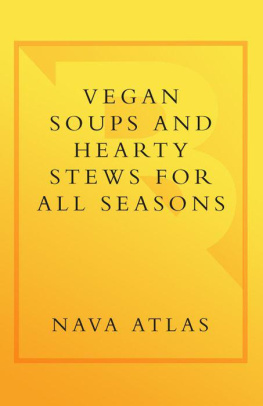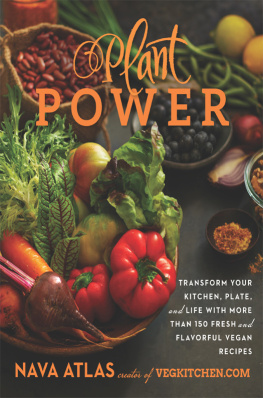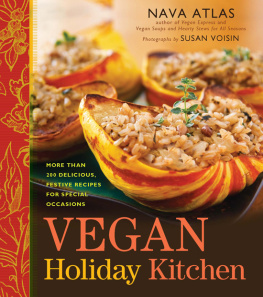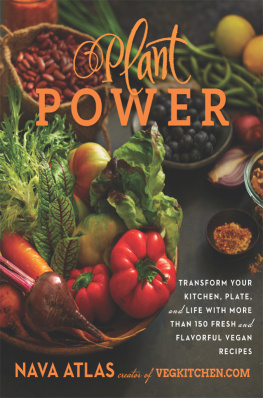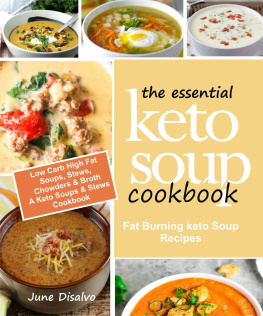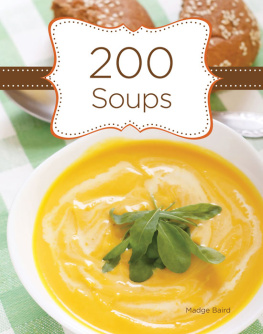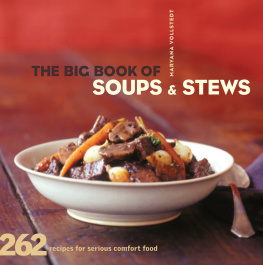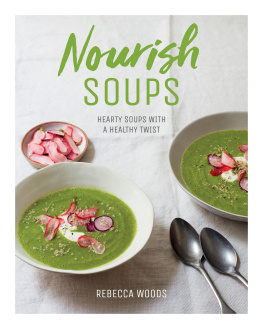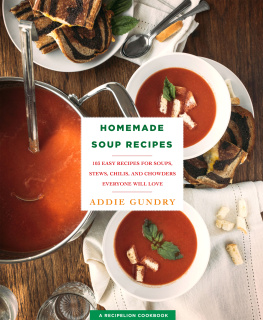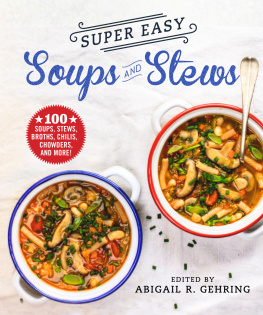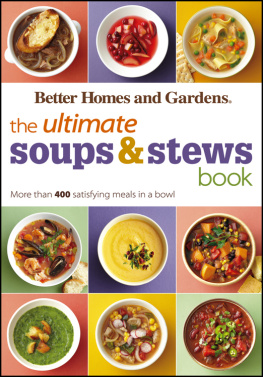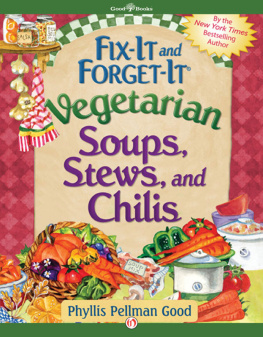I NTRODUCTION AND B ASICS
Soups have always held a prominent spot in my culinary repertoire, being one of the easiest, yet most rewarding, of all preparations in the kitchen. One hardly needs to go beyond the most basic of ingredients and equipment to create a wonderfully diverse range of possibilities and results: A soup might be familiar and soothing, evoking memories of the warmth and comfort of a childhood home, or it might be a mlange of sophisticated flavors that meld together in a pleasantly unexpected way. Or with a bit less liquid and a tad more chunkiness of texture, the result is stewa savory and satisfying one-pot meal.
Soups and stews are welcome at any time of year, reflecting the harvest of each season. Good soups and stews can:
brighten a humdrum winter day and give comfort when colds and viruses hit
showcase the tender new produce of spring or the bounty of falls harvest
transform the lush diversity of summers fruits and vegetables into refreshing elixirs
This new edition (this books fourth) reflects the decision I made a few years ago to go vegan, following in the footsteps of my sons. My husband and I raised our sons as lacto-ovo vegetarians from birth; our youngest son, at age 10, decided to become a vegan for ethical reasons. Our older son, then not quite 13, followed suit shortly thereafter. Inspired by their conviction, it didnt take long for my husband and me to join them.
Being vegan in the 21st century is not much different from being a vegetarian. There are many substitutions for dairy products (including soy, rice, and nut-based milks, cheeses, and the like), and unless you crave omelets, its surprisingly easy to dispense with eggs in the diet. I love to bake, and happily discovered that eggs are just not necessary to make good baked goods. This is reflected in the revised chapter of accompaniments, which includes quick breads, muffins, biscuits, and such.
Veganism is primarily about ethicswhat we put on our plates reflects ideals about having compassion toward all living beings, saving the environment from the ravages of animal agriculture, and preventing diseases caused by the Western diet. But veganism is also about enjoyment of great foodvegans may have political palates, but they are also quite discerning. The many vegan restaurants that have sprung up everywhere over the last decade feature some of the most creative, delicious food anywhere, and the gourmet food industry aimed squarely at the vegan market has blossomed tremendously. This love for fantastic fare served with a clear conscience is most gratifying in ones own kitchen.
From one soup lover to another, here are scores of soups for any time of year. It almost goes without saying that you need not be a veganor even a vegetarianto enjoy these recipes. Low in fat, high in fiber, and globally inspired, they are for everyone who appreciates fresh and flavorful seasonal produce, whole grains, healthful beans, legumes, and soyfoods, with the judicious use of herbs, spices, and other seasonings. Best of all is the sense of comfort and wonderful aromas imparted by a big pot of simmering soup or stew, whetting the appetite like nothing else can.
C OOKING N OTES
Beans: canned vs. cooked from scratch
Beans of all sorts are one of the cornerstones of vegan and vegetarian soup making. Theyre not only a superb low-fat, high-fiber protein source, but also add great flavor and texture to soups. In instances where beans are the primary ingredient of a soup, such as in Black Bean Soup (page 38) or Spicy Chili Bean Stew (page 67), dried beans are called for, so that they become the base of the soup. In most cases where a smaller amount of cooked beans is needed, I specify canned beans. Busy cooks are loathe to take the time and trouble to cook a small amount of beans from scratch, unless, of course, the extra is saved for later use or for freezing. By all means, if you prefer to cook beans from scratch no matter what, I will not discourage you.
That said, Id rather people use canned beans than forgo them altogether. There are several excellent organic brands to be found in natural food stores and well-stocked supermarkets. The advantage of these, aside from the obvious one (that they are organic), is that they are less salty than commercial brands. When using canned beans, I recommend draining and rinsing them of their salty liquid, which helps to mitigate the sodium factor. And of course, you can be more judicious when salting a soup that is made with canned beans.
Cooking equipment
The soups in this book are simple enough to require only the most basic of kitchen equipment. Aside from a large soup pot or Dutch oven, of course, the items needed are standard to most any kitchen: wooden spoons for stirring, a colander for washing leeks and leafy vegetables, a grater, measuring utensils, and good knives. For the devoted soup cook, I heartily recommend an immersion blender (see next page) or food processor for pureed soups; the food processor is also useful for making occasional grating easier and quicker.
Freezing soups
Some soups freeze well, but others lose much of their flavor and texture. Thick winter bean and grain soups do pretty well, as do simple broths and stocks. Freezing often changes the texture of a smooth puree, making it more watery. Avoid freezing soups that contain potatoes or lentils, both of which turn quite mushy. I dont recommend freezing soups containing raw ingredients, as in certain chilled soups. The soups in this book generally dont yield such enormous quantities to warrant long-term storage of leftovers. I prefer finishing most soups while they are fresh rather than after they have been frozen and thawed.
Immersion blender
This is a compact, inexpensive gadget featuring a small puree blade on the end of a wand. I love it and find it indispensable, not only for blending soups, but for making the fruit smoothies that we love in our household. Insert the blender into the pot of soup, press the button, and blend! Its also easy to clean and easy to store.
Oil and margarine
As youll soon see, my oil of choice in most soups is olive oil. Unless extra-virgin is specified (in those instances when its more assertive flavor is desired), you can use any kind of lighter olive oil, such as pure. On occasion, I will call for nonhydrogenated margarine. My favorite brand is Earth Balance. If you shop mostly in the supermarket, its equivalent is Smart Balance, which is made by the same company.
Organic ingredients
I like to use organic produce exclusively. I like to support organic growers, and I do not want my family to ingest pesticides. Im well aware that the standards for organic produce have been watered down, and that drift is an issue; however, by using organic produce as much as possible, its a matter of doing the best that one can. I encourage you to do so, too. In the warmer months, our family belongs to an organic community farm that is just a mile from our home. Using local produce as much as possible is also kind to the earth, and having access to produce that was picked the same day it is used is the ultimate culinary pleasure. If you cant use organic produce all the time, use it as often as you can. I also recommend using organic grains as well as canned and frozen products. Canned tomatoes and beans, and frozen corn and peas are ingredients often used in soups, for instance, and organic versions of these and other products are excellent.

